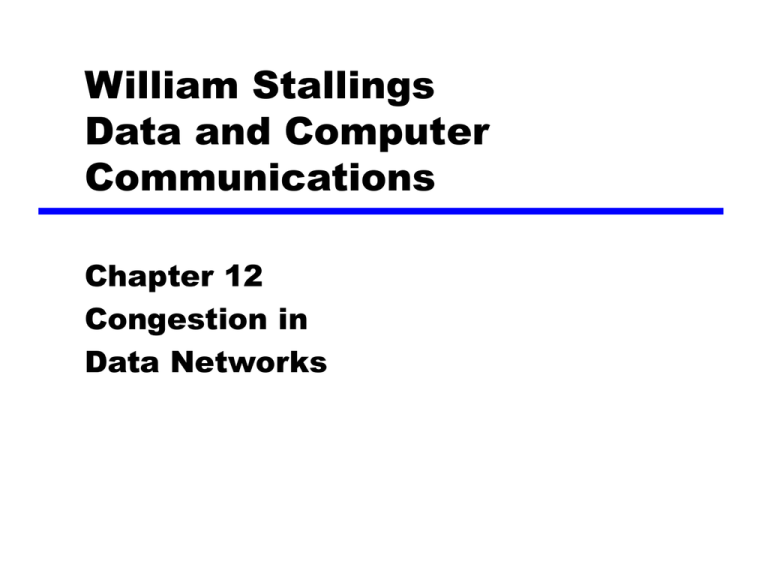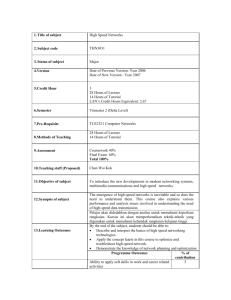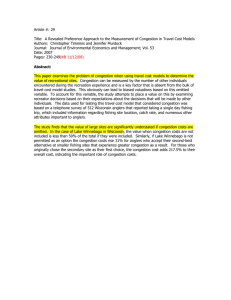William Stallings Data and Computer Communications Chapter 12
advertisement

William Stallings Data and Computer Communications Chapter 12 Congestion in Data Networks What Is Congestion? Congestion occurs when the number of packets being transmitted through the network approaches the packet handling capacity of the network Congestion control aims to keep number of packets below level at which performance falls off dramatically Data network is a network of queues Generally 80% utilization is critical Finite queues mean data may be lost Queues at a Node Effects of Congestion Packets arriving are stored at input buffers Routing decision made Packet moves to output buffer Packets queued for output transmitted as fast as possible Statistical time division multiplexing If packets arrive to fast to be routed, or to be output, buffers will fill Can discard packets Can use flow control Can propagate congestion through network Interaction of Queues Ideal Performance Practical Performance Ideal assumes infinite buffers and no overhead Buffers are finite Overheads occur in exchanging congestion control messages Effects of Congestion No Control Mechanisms for Congestion Control Backpressure If node becomes congested it can slow down or halt flow of packets from other nodes May mean that other nodes have to apply control on incoming packet rates Propagates back to source Can restrict to logical connections generating most traffic Used in connection oriented that allow hop by hop congestion control (e.g. X.25) Not used in ATM nor frame relay Only recently developed for IP Choke Packet Control packet Generated at congested node Sent to source node e.g. ICMP source quench From router or destination Source cuts back until no more source quench message Sent for every discarded packet, or anticipated Rather crude mechanism Implicit Congestion Signaling Transmission delay may increase with congestion Packet may be discarded Source can detect these as implicit indications of congestion Useful on connectionless (datagram) networks e.g. IP based (TCP includes congestion and flow control - see chapter 17) Used in frame relay LAPF Explicit Congestion Signaling Network alerts end systems of increasing congestion End systems take steps to reduce offered load Backwards Congestion avoidance in opposite direction to packet required Forwards Congestion avoidance in same direction as packet required Categories of Explicit Signaling Binary A bit set in a packet indicates congestion Credit based Indicates how many packets source may send Common for end to end flow control Rate based Supply explicit data rate limit e.g. ATM Traffic Management Fairness Quality of service May want different treatment for different connections Reservations e.g. ATM Traffic contract between user and network Congestion Control in Packet Switched Networks Send control packet to some or all source nodes Requires additional traffic during congestion Rely on routing information May react too quickly End to end probe packets Adds to overhead Add congestion info to packets as they cross nodes Either backwards or forwards ATM Traffic Management High speed, small cell size, limited overhead bits Still evolving Requirements Majority of traffic not amenable to flow control Feedback slow due to reduced transmission time compared with propagation delay Wide range of application demands Different traffic patterns Different network services High speed switching and transmission increases volatility Latency/Speed Effects ATM 150Mbps ~2.8x10-6 seconds to insert single cell Time to traverse network depends on propagation delay, switching delay Assume propagation at two-thirds speed of light If source and destination on opposite sides of USA, propagation time ~ 48x10-3 seconds Given implicit congestion control, by the time dropped cell notification has reached source, 7.2x106 bits have been transmitted So, this is not a good strategy for ATM Cell Delay Variation For ATM voice/video, data is a stream of cells Delay across network must be short Rate of delivery must be constant There will always be some variation in transit Delay cell delivery to application so that constant bit rate can be maintained to application Time Re-assembly of CBR Cells Network Contribution to Cell Delay Variation Packet switched networks Queuing delays Routing decision time Frame relay As above but to lesser extent ATM Less than frame relay ATM protocol designed to minimize processing overheads at switches ATM switches have very high throughput Only noticeable delay is from congestion Must not accept load that causes congestion Cell Delay Variation At The UNI Application produces data at fixed rate Processing at three layers of ATM causes delay Interleaving cells from different connections Operation and maintenance cell interleaving If using synchronous digital hierarchy frames, these are inserted at physical layer Can not predict these delays Origins of Cell Delay Variation Traffic and Congestion Control Framework ATM layer traffic and congestion control should support QoS classes for all foreseeable network services Should not rely on AAL protocols that are network specific, nor higher level application specific protocols Should minimize network and end to end system complexity Timings Considered Cell insertion time Round trip propagation time Connection duration Long term Determine whether a given new connection can be accommodated Agree performance parameters with subscriber Traffic Management and Congestion Control Techniques Resource management using virtual paths Connection admission control Usage parameter control Selective cell discard Traffic shaping Resource Management Using Virtual Paths Separate traffic flow according to service characteristics User to user application User to network application Network to network application Concern with: Cell loss ratio Cell transfer delay Cell delay variation Configuration of VCCs and VPCs Allocating VCCs within VPC All VCCs within VPC should experience similar network performance Options for allocation: Aggregate peak demand Statistical multiplexing Connection Admission Control First line of defence User specifies traffic characteristics for new connection (VCC or VPC) by selecting a QoS Network accepts connection only if it can meet the demand Traffic contract Peak cell rate Cell delay variation Sustainable cell rate Burst tolerance Usage Parameter Control Monitor connection to ensure traffic cinforms to contract Protection of network resources from overload by one connection Done on VCC and VPC Peak cell rate and cell delay variation Sustainable cell rate and burst tolerance Discard cells that do not conform to traffic contract Called traffic policing Traffic Shaping Smooth out traffic flow and reduce cell clumping Token bucket Token Bucket ATM-ABR Traffic Management Some applications (Web, file transfer) do not have well defined traffic characteristics Best efforts Allow these applications to share unused capacity If congestion builds, cells are dropped Closed loop control ABR connections share available capacity Share varies between minimum cell rate (MCR) and peak cell rate (PCR) ARB flow limited to available capacity by feedback Buffers absorb excess traffic during feedback delay Low cell loss Feedback Mechanisms Transmission rate characteristics: Allowed cell rate Minimum cell rate Peak cell rate Initial cell rate Start with ACR=ICR Adjust ACR based on feedback from network Resource management cells Congestion indication bit No increase bit Explicit cell rate field Variations in Allowed Cell Rate Cell Flow Rate Control Feedback EFCI (Explicit forward congestion indication) marking Relative rate marking Explicit rate marking Frame Relay Congestion Control Minimize discards Miantain agreed QoS Minimize probability of one end user monoply Simple to implement Little overhead on network or user Create minimal additional traffic Distribute resources fairly Limit spread of congestion Operate effectively regardless of traffic flow Minimum impact on other systems Minimize variance in QoS Techniques Discard strategy Congestion avoidance Explicit signaling Congestion recovery Implicit signaling mechanism Traffic Rate Management Must discard frames to cope with congestion Arbitrarily, no regard for source No reward for restraint so end systems transmit as fast as possible Committed information rate (CIR) Data in excess of this liable to discard Not guaranteed Aggregate CIR should not exceed physical data rate Committed burst size Excess burst size Operation of CIR Relationship Among Congestion Parameters Explicit Signaling Network alerts end systems of growing congestion Backward explicit congestion notification Forward explicit congestion notification Frame handler monitors its queues May notify some or all logical connections User response Reduce rate Required Reading Stallings chapter 12



